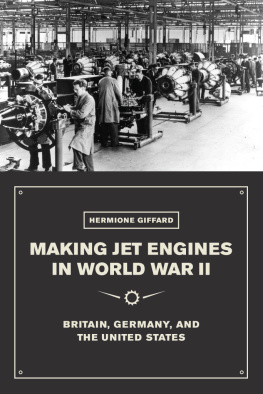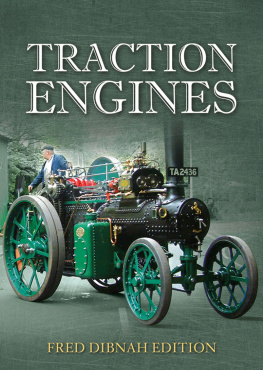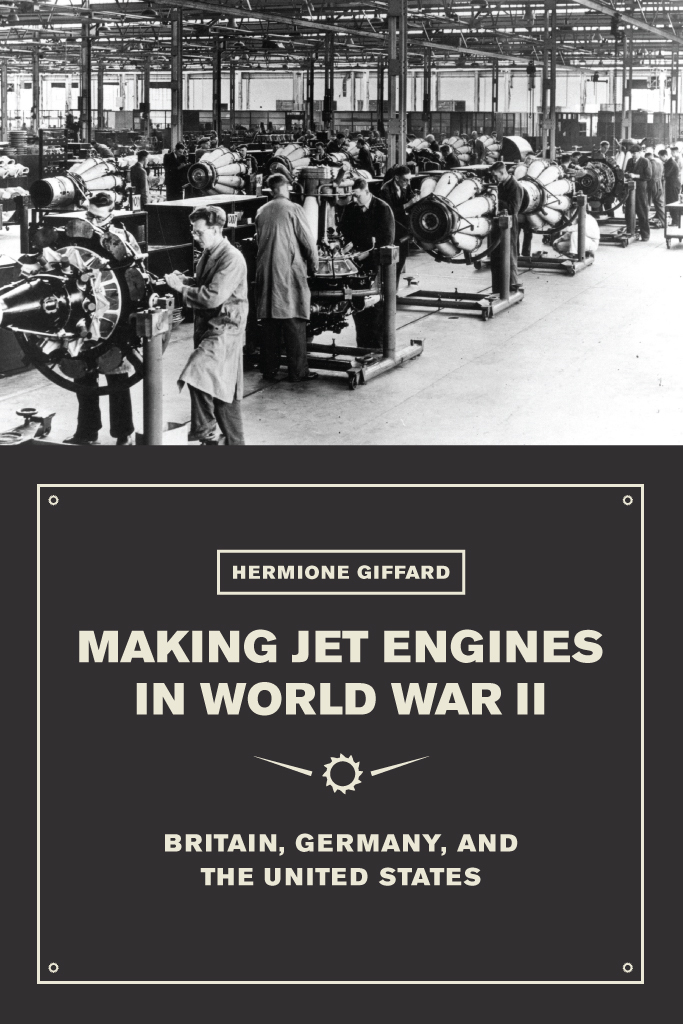Making Jet Engines in World War II
Britain, Germany, and the United States
HERMIONE GIFFARD
THE UNIVERSITY OF CHICAGO PRESS
CHICAGO AND LONDON
HERMIONE GIFFARD is a postdoctoral researcher in the Department of History and Art at Utrecht University, in the Netherlands.
The University of Chicago Press, Chicago 60637
The University of Chicago Press, Ltd., London
2016 by The University of Chicago
All rights reserved. Published 2016.
Printed in the United States of America
25 24 23 22 21 20 19 18 17 16 1 2 3 4 5
ISBN -13: 978-0-226-38859-5 (cloth)
ISBN -13: 978-0-226-38862-5 (e-book)
DOI : 10.7208/chicago/9780226388625.001.0001
Library of Congress Cataloging-in-Publication Data
Names: Giffard, Hermione, author.
Title: Making jet engines in World War II : Britain, Germany, and the United States / Hermione Giffard.
Description: Chicago ; London : The University of Chicago Press, 2016. | Includes bibliographical references and index.
Identifiers: LCCN 2016001733 | ISBN 9780226388595 (cloth : alk. paper) | ISBN 9780226388625 (e-book)
Subjects: LCSH : Jet enginesGreat Britain. | Jet enginesGermany. | Jet enginesUnited States. | World War, 19391945Equipment and supplies.
Classification: LCC D 810.S2 G 54 2016 | DDC 623.74/6044dc23 LC record available at http://lccn.loc.gov/2016001733
 This paper meets the requirements of ANSI/NISO Z 39.48-1992 (Permanence of Paper).
This paper meets the requirements of ANSI/NISO Z 39.48-1992 (Permanence of Paper).
DEDICATED TO MY FATHER, WHO GAVE ME THE TOOLS
Contents
BMW | Bayrische Motorenwerke |
Bramo | Brandenburgische Motorenwerke |
GTCC | Gas Turbine Collaboration Committee |
ICT | Internal Combustion Turbine |
Jumo | Junkers Motorenwerke |
MAP | British Ministry of Aircraft Production |
Metrovick | Metropolitan Vickers |
RAE | Royal Aircraft Establishment |
RLM | Reichsluftfahrtministerium, German Air Ministry |
This book is about making new machines and about how we understand this. Its aim is to present a fresh history of the many jet engines that were in use and designed in Britain, Germany, and the United States by 1945. In the light of this, it seeks to stimulate historians to rethink the history of the emergence of technical novelty, especially but not only in the mid-twentieth century. Rather than tell the story of making the jet engine as the story of a few individual inventors, I focus on the previously neglected work of industrial firms in designing, developing, and producing them. Appealing to aeronautical engineers for their potentially high power-to-weight ratio (the increase in which was an all-consuming goal for extremely weight-conscious aero-engine makers) and their lack of propeller (which worked poorly at high altitudes), the attraction of the jet engine had to be balanced against the practical difficulties of making one work and producing it in large numbers. As this book shows in detail, the jet engine was not only the product of new ideas but also crucially of existing technical resources and skills that were redeployed and refined. In this picture, the famous jet engine inventors are understood as parts of larger inventive institutions that deeply influenced their work. These institutions are in turn understood as fitting into a broader context: the systems responsible for producing usable innovations in aeronautical technology (primarily for national air forces), systems that included national governments, commercial firms, and research institutes. There was little obvious correlation between the moment that any man became dedicated to the jet engine and the start of production of jet engines in any of the three countries studied here. Furthermore, the production of deployable jet engines by industrial firms was in all cases begun before development and thus innovation had been completed. This had a profound effect on what was developed, when, and how. The story told here is the story of the complex interaction between expectation, production, development, and innovation.
Paying attention to production and to industry has important interpretive consequences for the story of the jet engine. It transforms the standard story in which Germany surged ahead during the war while Britain was left behind and the United States failed entirely to advance. This book shows that Britain quickly decided to focus on the development of large numbers of new engine types for the postwar world and, despite a rushed and largely symbolic deployment of jets during the war, emerged from the war with by far the strongest portfolio of new engines of any country. National Socialist Germany, in contrast, produced a very large number of dangerous jet engines as a replacement for more expensive piston engines; their jet engines can be understood as an ersatz technology. The United States was in even less of a hurry to deploy jet engines during the war than Britain, and indeed, it did so only in very small numbers. It used the war to build up its capability to manufacture jet engines. American aero-engine firms, which had been explicitly excluded from jet engine development during the war, did not turn in the postwar period to confiscated German jet engines as a basis for future development but instead licensed British jet engines with wartime heritages. Looking in detail at the creation of the earliest jet engines explains why the engines produced by each nations aero-engine firms took the shapes they did and underlines the many important continuities in design, tacit knowledge, management, and equipment that linked piston engine and jet engine production.
The stories that are commonly told about the creation of the first jet engines in Britain and Germany have done great violence to that early historyit has become a story of firsts and of single inventors, with the production of engines understood as little more than the principal measure of inventive success. The standard story focuses on two inventors from outside the aero-engine industry: Frank Whittle, a young officer in the Royal Air Force, and Hans von Ohain, a young German physicist. Their work supposedly culminated in the first jet flights by the Royal Air Force and Luftwaffe during World War II. According to this story, Whittle developed the idea of a jet engine in 1930 but was delayed in pursuing his idea by a lack of government interest and, as a result, was ultimately forced to form a private company to develop his jet engine. The first Whittle engine ran on April 12, 1937, and the first jet flight in Britain took place on May 15, 1941. The standard story argues that the delay in developing Whittles idea let Germany overtake Britain in jet engines. Unlike Whittle, who struggled for many years, the story tells us that the inventor Hans von Ohain quickly found support for his work from the German aircraft company owner Ernst Heinkel in 1936. Von Ohains first engine ran on the bench in 1937, and on August 27, 1939, a von Ohain engine powered a Heinkel airframe in Germanys (and the worlds) first jet powered flight. Both Britain and Germany deployed their jet fighters in July 1944. Yet Germany produced far more jet engines than any other country during the war, proving, in the standard story, German superiority. In all measures, the United States lagged behind Germany and Britain in jet engines. According to the standard account, the United States Army Air Forces had to copy Whittles engine in order to jumpstart American jet engine development because they lacked a jet inventor of their own. Despite this, no American jet aircraft were deployed to fight the war.











 This paper meets the requirements of ANSI/NISO Z 39.48-1992 (Permanence of Paper).
This paper meets the requirements of ANSI/NISO Z 39.48-1992 (Permanence of Paper).